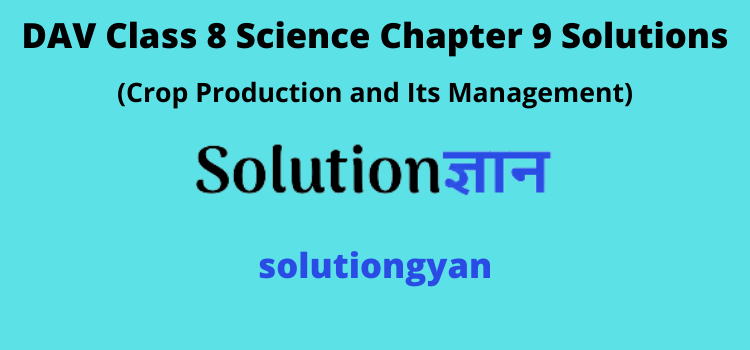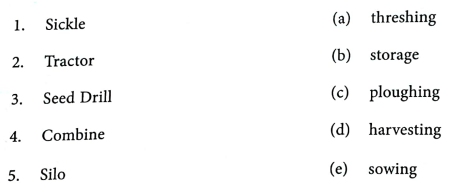DAV Class 8 Science Chapter 9
DAV Class 8 Science Chapter 9 Crop Production and Its Management Solutions of The Living World Book guides you with the answers to the questions given in the textbook. Class Eight is an important phase of the student’s life as they are introduced to many new concepts that are essential to set strong basics foundation for the topics to be taught in Class 9. To score very good marks in the DAV Class 8 examination students should solve the questions provided at the end of each chapter in Class 8 DAV books.

Solving DAV questions will assist you in grasping the content in the Crop Production and Its Management chapter in a better way. SOLUTIONGYAN presents the important questions at the end of each chapter according to the updated latest Class 8 DAV Syllabus.
These DAV Class 8 Science Chapter 9 Crop Production and Its Management Solutions will help you in scoring good marks as they cover important concepts in different patterns like fill in the blanks, match the following, tick the correct option, short answer questions, long questions answer and more. DAV Class 8 Science Chapter 9 Crop Production and Its Management Solutions is provided here for better understanding and clarification of the subject.
DAV Solutions for Class 8 Science Chapter 9 Crop Production and Its Management
DAV Class 8 Science Chapter 9 Crop Production and Its Management Solutions is given below. Here DAV Class 8 Science Chapter 9 Question Answer is provided with great explanation.
Highlights
- Fill in the blanks.
- Match the following.
- Tick the correct option.
- Answer the following questions in brief.
- Answer the following questions.
If you are looking for more solution of DAV Class 8 then you can freely visit or check our site SOLUTIONGYAN. We regularly update our site with new content every day. So, you can check it regularly for latest content.
A. Fill in the blanks.
1. ___________ results in loosening and mixing of soil.
2. ___________ compete with crops for nutrients.
3. ___________ bacteria, present in the root nodules of ___________ plants, help in fixing atmospheric nitrogen.
4. Harvested grains are ___________ to reduce moisture content.
5. Removal of anthers, from the flowers, is known as ___________.
Answer: (1) Ploughing (2) Weeds (3) Rhizobium, leguminous (4) dried (5) emasculation.
B. Match the following.

Answer: (1) d (2) c (3) e (4) a (5) b
C. Tick the correct option.
1. The practice, of growing leguminous plants between successive cereal crops, is called-
Answer: crop rotation
2. Which among the following is a Kharif crop?
Answer: rice
3. The organic substance, obtained from dead plants, animals and their wastes is known as-
Answer: manure
4. The process of separating grain from chaff is known as-
Answer: winnowing
5. Crops, which are grown during the rainy season, are known as-
Answer: kharif crops
D. Answer the following questions in brief.
1. Why is the use of a seed drill more advantageous as compared to sowing seeds by broadcasting?
Answer: Seed drill helps in saving labour cost and time. Hence, seed drill is more advantageous as compared to sowing seeds by broadcasting.
2. Babu wants to practice crop rotation. Help him by suggesting what kind of crops can be grown between two consecutive cereal crops? Also, provide him names of one Rabi and one Kharif crop that can be used to replenish the nitrogen content of the soil.
Answer: Babu should grow pulses between two consecutive cereal crops. Groundnut (Kharif) and Pea (Rabi) crops can be used to replenish the nitrogen content of the soil.
3. If rice is sown in the month of November, how is the produce likely to be impacted? And why?
Answer: If rice is sown in the month of November, then it will not get adequate temperature, sunshine, and water. This will result in low productivity of rice crop.
4. What are crumbs? Why should they be broken?
Answer: A ploughed field has big pieces of soil called crumbs. They should be broken, so that air circulation in soil takes place and seeds can easily enter and germinate through the soil.
5. Define the term ‘transplantation’? List any two advantages it offers to the farmer.
Answer: In some crops, like paddy seeds are sown in a small plot called nursery. When seedlings are formed, they are manually planted in the field. This is known as transplantation.
Two advantages transplantation offers to the farmer are:
- It enables the farmer to selectively cultivate only healthy plants.
- They can be planted at uniform distance to ensure uniform availability of water, sunlight etc.
E. Answer the following questions.
1. State the advantages of ploughing the soil. State the different ways through which it is done.
Answer: The advantages of ploughing the soil are:
- It improves air circulation, so that roots can respire easily.
- Roots can penetrate deeper into the soil; this enables them to hold the plant firmly.
- Ploughing enhances the water retaining capacity of the soil.
- Ploughing uproots the weeds growing in the field; it also aids in the growth of the microbes.
It is done by using a wooden or iron plough which is pulled either by oxen, or by a tractor.
2. Both manures and fertilisers replenish soil fertility. Compare and contrast the advantages and disadvatages of using them.
Answer:
Advantage of using manures:
- It is cheap.
- It increases the water-holding capacity of the soil.
- The number of microbes increases in the soil.
- The texture of the soil improves.
Advantage of using fertilisers:
- They are portable and easy to transport.
- They are readily absorbed by the plants.
- They are quick in providing plant nutrients and restoring soil fertility.
- Fertilisers improve and increase the productivity of many crops such as maize, wheat, and rice.
Disadvatages of using manures:
- It is not easy to store and transport.
- Manure provides less nutrient to plants in comparison to fertilizers.
Disadvantages of using fertilisers
- Fertilisers are costly.
- Overuse of fertilisers can change the chemical nature of the soil.
3. Explain how weeds are harmful for plants. State the different ways of weed removal practiced by farmers.
Answer: Weeds are the unwanted plants, that grow along with the crops and hinders its growth. It uses up nutrients which are meant for the crop. They also compete for water and light and thus affect the production of the crop.
The different ways of weed removal practiced by farmers are
Manual removal: Weeds can be removed by uprooting unwanted plants with the help of trowel (khurpi) or harrow.
Tilling before sowing: Ploughing the field, before sowing the seeds, uproots the weeds. Weeds then dry up and get mixed up with the soil.
Weedicides: These are chemicals which kill the weeds but do not harm. the crops. These are sprayed on the fields.
4. Give reasons for the following:
(a) Excess water supply can damage crops.
Answer: Excessive supply of water can reduce air in the soil spaces and can cause water logging. This can damage the plant roots and can cause them to die.
(b) Grains are not stored without sun-drying.
Answer: Harvested food grains often contain more moisture than is suitable for their storage. Hence, these grains are sun-dried before storing. This prevents growth of microbes on them.
(c) Overuse of pesticides should be avoided.
Answer: Overuse of pesticides should be avoided because these pesticides stick to fruits and vegetables, and are also absorbed by plants. They can, therefore, become a part of the food chain. It is for this reason that the use of the pesticides must be kept to the bare minimum.
5. Bhola’s field is ready with a mature wheat crop. List and explain the steps he would have to undertake before selling the grains to the FCI (Food Corporation of India).
Answer: Bhola will take following steps before selling the grains:
Step 1: Harvesting: Cutting and gathering of crops, after maturation, is known as harvesting.
Step 2: Threshing: After harvesting, grains are separated from the cut crop. This process is called threshing. This can be done manually or by a machine called thresher.
Step 3: Winnowing: After threshing, grains are separated from the chaff. This is known as winnowing.
Step 4: Storage: Grains are dried in sun to remove moisture. After that, grains are stored in granaries and silos which are designed to protect grains from rats and insects. This is done by Food Corporation of India (FCI).
6. Define hybridisation. List the steps to be followed for obtaining seeds of a hybrid variety.
Answer: Hybridisation is the process of crossing two genetically different ‘individuals’ to obtain a new ‘individual’ (hybrid) exhibiting desirable characteristics.
Steps to be followed for obtaining seeds of a hybrid variety are as follows:
Step 1: Two varieties of plants, say A and B, of desired characteristics are chosen.
Step 2: Anthers from plant ‘A’ are removed. This process is called emasculation.
Step 3: Anthers from plant ‘B’ are taken and its pollen are dusted on stigmas of ‘A.
Step 4: Stigmas of ‘A’ are then covered by paper bags.
Step 5: By such cross breeding of two desired varieties, seeds of a hybrid variety can be obtained.

thanks
Thank you so much